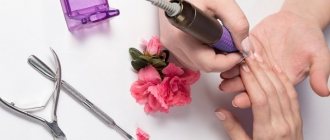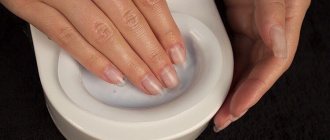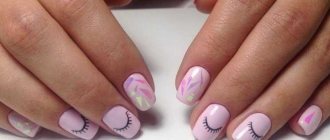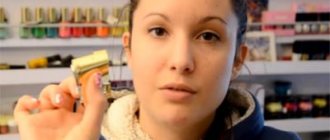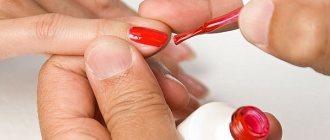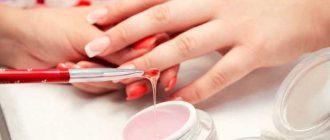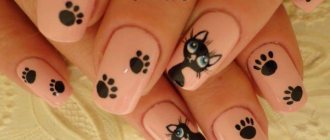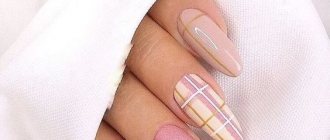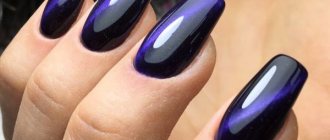Neat nails are an important part of the appearance of a well-groomed girl, which is why manicures with gel polish are gaining popularity. But to get a perfectly even coating, you need to make an appointment with a specialist, go to a salon or someone’s home, and hope that they will do the job exactly the way you wanted. Of course, doing your own manicure is much more convenient and cheaper.
Do you think learning how to do a manicure is difficult? We will try to prove you wrong!
In this article we will tell you:
- What is gel polish? Its pros and cons
- How to learn how to do a manicure with gel polish
- What you need for a manicure at home
- Step-by-step lesson - how to do a manicure with gel polish at home
- How to do a hardware manicure
- How to choose cutters for hardware manicure
- Step-by-step lesson on hardware manicure
- How to choose a machine for hardware manicure
- How to choose a lamp for manicure
- How to properly sterilize manicure instruments
- Where to learn manicure and how to choose the right manicure courses
Manicure courses for yourself in St. Petersburg
What is gel polish and how does it work?
First, let's figure out what gel polish is? This durable polymer nail coating is a well-known and popular manicure option today.
Pros of gel polish
Gel polish coating has several advantages , which is why it is much more popular than regular polishes.
- Gel polish is durable - lasts from two weeks to a month and pleases the owner with its appearance.
- The strength of gel polish allows the manicure to retain its color, does not rub off from the nails or get scratched, does not allow the nails to break, and they grow faster.
- A wide range of gel polishes allows you to choose a coating that will not spoil your nails and, on the contrary, will strengthen them.
- The choice of color palette and designs is huge. You can create different colors, patterns and combinations of patterns - it will be useful for all lovers of “something new”.
How to learn how to do a manicure with gel polish yourself?
We promised that learning how to do a manicure is easy! Now we’ll tell you exactly how you can do a manicure yourself at home.
A gel polish manicure is done in two stages: first a simple manicure, and then applying gel polish to the nails.
Advice
First of all, purchase or prepare the necessary tools
To create a neat manicure you will need:
- sharp manicure scissors
- wire cutters
- orange wood cuticle stick
- nail file and polisher
- gel polish of the desired color
- transparent base
- top coating
- drying lamp
- tassels for design
- additional decorations: sparkles, tints, sliders, etc.
Some of these tools can be replaced with a manicure machine, which will allow you to remove cuticles faster and easier.
Step-by-step instructions on how to do a manicure at home
- Use a nail file to create the desired shape for your nails. The picture shows several options for nail shapes that you can make.
- Push back and lift the cuticle using an orange stick and carefully remove it with scissors or nippers.
- Degrease your nails with a good degreaser. Do not use alcohol for this purpose - it dries out the nail plates and you risk damaging your nails!
- We begin to apply gel polish. First, coat your nails with a clear base coat (base), then dry your nails in a lamp for about 30 seconds.
- Apply colored gel polish in the same way as you would apply regular polish. Gel polish needs to be dried in a lamp for about 1 minute.
- For a more saturated color, you can apply a second layer of colored gel polish, and then fix it by drying it under ultraviolet light.
- If you want to draw something on your nails, stick sliders (a variety of stickers on your nails) or decorate your nails with an unusual stamp, you will need special tools and materials. For any of the methods, the technique is the same - apply the desired design to the nail, dry it in a lamp for 30 seconds.
- Secure the result with a top coat. “Cover” the side cut of the nail with varnish and dry the result in a lamp.
- File your nails if necessary.
- Moisturize your nails and fingers with oil or light cream.
- Your wonderful manicure is ready!
Simple designs for the beginner manicurist
Step-by-step photos of fashionable manicures and video tutorials on manicure at home will allow you to quickly master popular techniques. You just have to stock up on free time and patience. Enjoy watching!
- Simple drawings
- Flowers and patterns
- Rhinestones
- Kamifubuki
- Rubbing
- Broken glass
How to do a hardware manicure?
You can also prepare your nails for applying varnish using a special machine. This type of manicure is called hardware manicure. There is nothing complicated about it, but it looks neater and is much faster.
What are cutters for hardware manicure?
The peculiarity of hardware manicure is that many cutter attachments are used, each of which performs its own functions when processing the cuticle of the fingers during a manicure. Mills are attachments for a manicure machine.
How to choose cutters depending on the material:
- Diamond cutters are not only the most expensive and hardest, but also the most effective. They work best with delicate skin.
- Ceramic cutters are the most common type. Such cutters are used by both experienced craftsmen and beginners.
- Metal cutters are a tool for professionals. You need to work with them carefully.
- Silicon carbide cutters are the best option for beginners. They are the cheapest and are considered disposable.
Milling cutters made from different materials are used in the same way, but the harder the material, the more difficult it is to work with. An experienced craftsman can handle cutters made of different materials equally well and work even with the most delicate skin.
What shapes of cutters will be useful for a novice craftsman:
- Cone-shaped cutters are needed for grinding and polishing the side ridges of the nail.
- A ball-shaped bur is necessary for removing irregularities and cracks.
- Cylindrical cutters are used to create nail shapes and remove gel polish.
- Bullet polishers are made from soft materials such as silicone or plastic and are used for finishing and polishing.
Recommendations for working with the manicure device:
- Only dry cuticles should be treated with the device, otherwise they will heat up and you risk damaging them.
- Do not press the device too hard against your nail, otherwise you may damage the structure of the nail plate.
- First, practice using silicone tips. This will help you master the machine and learn how to operate it.
Ready? You can start creating the perfect manicure!
How to do a hardware manicure - step-by-step instructions:
- Remove the cuticle on the side edges of the nail using a needle-shaped (cone-shaped) cutter. The rotation speed of the cutter should be about 1200 rpm.
- Using the same cutter, we carefully lift the cuticle, running the device along the lower edge of the nail. Be careful, delicate thin skin is very easy to hurt!
- Using a truncated cone cutter running at 1000 rpm, remove cuticles from the nail.
- Using a bullet polisher, gently buff the cuticles.
- If the skin around the nail also requires treatment, use a ball-shaped cutter and go over all the bumps and cracks in the skin around the nail plate.
- To give the nail the desired shape, go along the edge of the nail with a cylindrical cutter.
- Your nails are perfect - apply gel polish!
How to do trim manicure at home:
Trim manicure (video tutorials for beginners can be viewed on many resources) can also be done at home. The whole procedure is carried out in several stages: preparation of the nail plate, preparation of the skin, treatment of the skin with an instrument.
Below are step-by-step instructions:
- It is necessary to prepare the workplace. It should be well lit by daylight or a lamp, and kept clean. It is better to use a clean towel or disposable tablecloth to cover the surface.
- First, you should lay out your tools, consumables, and antiseptics.
- It is necessary to treat your hands with an antiseptic (chlorhexidine or alcohol antiseptic), paying attention to the cuticle area. The skin antiseptic must be rubbed into the fingers, spaces between the fingers, palms and nail plates.
- If necessary, you can remove the old coating from your nails using nail polish remover.
- Using clippers and a file, you should give your nails the desired shape. To ensure that the length is the same, you can use nail extension forms. Each form has markings indicating the length and width. After sawing, you need to remove dust with a nail brush or a damp lint-free cloth.
- You can soften the cuticle in two ways: by soaking the skin in a bath (classic method), or using cuticle softeners (combined manicure method). In the first case, you need to dip your fingers in warm water for 5 minutes. You can use a regular bowl or a special manicure bath as a container. You can add oils or sea salt to the water. In the second case, apply the product to the cuticle area for 30-60 seconds.
- The softened skin is moved with a pusher or an orange stick with gentle movements towards the nail hole. If you press too hard on the nail plate, grooves or white spots may form on it.
- Next, pat your skin with a dry towel to absorb excess moisture.
- Using wire cutters or scissors at an angle of 45 degrees, make the first cut at the side roller. When using scissors, you should hold them with the blades bent upward. Next, moving the lower blade of the tool under the cuticle line, continue to make a cut along the perimeter of the cuticle, without making sudden movements. In the middle of the cuticle line, the instrument lies parallel to the skin. Closer to the edges of the side rollers, the angle of inclination of the instrument to the skin increases.
- After removing the cuticle, apply oil to your nails and lightly massage each finger.
- The last stage is cleaning the workplace and treating the instrument with an antiseptic solution.
How to choose a machine for hardware manicure?
We figured out how to do a hardware manicure. But how to choose the right manicure machine? There is nothing complicated about this either, the main thing is to understand why you need it.
When choosing a manicure machine, ask yourself these questions:
—What will your machine be used for?
A manicure machine will be significantly cheaper than a manicure and pedicure machine.
— Are you buying a device for yourself or for work as a manicurist?
For professional work, choose a higher-quality and longer-lasting machine, since you will have to use it much more often.
— Will you use it in the salon or at home?
A manicure machine with less power is suitable for home use, while a “severe” professional machine will be needed for a salon.
— Will you work as a manicurist on the road?
If you're working in a client's home, look for lighter models. Included with the machine, purchase a carrying case.
— Are you comfortable working with a manicure machine?
You must understand that the comfort of working with the machine is individual. If possible, touch the manicure device, hold it in your hands, imagine whether it will be convenient for you to work with it.
By answering these simple questions for yourself, you can easily choose the machine that is right for you.
How to choose a lamp for manicure?
A lamp is a necessary thing when creating a manicure with gel polish. They come in several types and are divided by type of radiation:
- Ultraviolet manicure lamps. Inside there are fluorescent lamps that emit ultraviolet light. These are the cheapest lamps and are suitable for beginners. Remember that the radiating element inside needs to be changed every two to three months.
- LED lamps. These lamps contain LEDs. This option is used most often by craftsmen. They are not cheap, but they are superior to UV lamps in power.
- CCFL lamps . There are gas lamps inside. When an electric current passes through this gas, the lamp emits the light necessary for the varnish to harden. Such lamps last for several years and consume little electricity.
- Hybrid lamps for manicure . Hybrid lamps combine all three technologies mentioned above and reduce the curing time of gel polish. They are expensive, but among them you can also find a budget option.
The power of the lamp does not depend on its type. All devices are divided into 9-, 12-, 18-, 36- and 45 - 54 watt.
Training on how to create a manicure and apply gel polish through video tutorials
Visual perception plays a very important role in our daily lives, helping in learning and making it possible to convey important information quickly and clearly. First we look, then we process what we see and in a matter of minutes we understand what needs to be done.
In the modern world, most women perceive visual information much better than huge canvases with many letters. Therefore, I suggest you watch a few video tutorials on how to create a manicure with gel polish . I tried to make for you a selection of the most useful video materials, which at one time helped me a lot in becoming a professional in the field of creating gel polish manicure.
Videos for beginners
Video tutorial No. 1 “Full review: starter kit for gel polish. Part 1"
Video tutorial No. 2 “Full review: starter kit for gel polish. Part 2"
Video lesson No. 3 “Removing the old coating and making a new one”
Video tutorial No. 4 “Gel polish manicure at home with a detailed discussion of all sorts of subtleties”
Video tutorial No. 5 “How to apply/remove gel polish”
Video master class from professional cosmetologists
Video No. 1 “Step-by-step instructions for applying gel polish”
Video No. 2 “Three effective ways to remove gel polish”
Video No. 3 “Removing gel polish with a cutter + hardware manicure. Part 1"
Video No. 4 “Complicated repair, extension and straightening of nails. Part 2"
Video No. 5 “Gel polish correction. Combined manicure for beginners with one cutter. Part 1"
Video No. 6 “Applying gel polish under the cuticle: leveling + strengthening + highlights. Part 2"
How to properly sterilize instruments?
We learned how to properly sterilize instruments from an experienced manicurist, Maria Kaverzneva.
Unfortunately, not all clients know that instruments must go through several stages of disinfection and sterilization. The most important thing is a clean instrument.
Clean does not mean washed in soapy water or a disinfectant solution; clean means sterile. And sterilization is the complete destruction of microorganisms, which occurs under the influence of heat at 180 degrees and above.
After each client, all tools (except for orange sticks and disposable nail files, which I throw away) go through several stages of processing.
Stages of sterilization of a manicurist’s tools:
Stage 1 is disinfection and pre-sterilization cleaning. The instruments are soaked in a special disinfectant liquid (I use Aminaz-Plus) and kept in it for a certain amount of time.
Stage 2 - the instrument is thoroughly washed with a brush under running water, dried and placed in a separate hermetically sealed bag - a craft bag.
Stage 3 - the craft package with tools must be placed in a dry-heat oven for 2 hours (along with cooling) at a temperature of 180 degrees. A dry-heat oven is an important stage; it sterilizes any metal instruments (scissors, wire cutters, cutters) with hot air, heated to 180-200 degrees. When using this device, all sterilization standards are observed (it is required by the Sanitary and Epidemiological Station), since it kills 99.9% of all diseases.
After sterilization, the instruments are safely stored in a closed craft bag, which ensures their sterility for up to 20 days and is only taken out in front of the client.
How can you be sure that the instrument is sterile? There is an indicator on the craft package that allows you to determine that sterilization has been carried out. It should be brown or pink.
Remember! No amount of “alcohol” or daily soaking in the solution kills HIV and hepatitis, just like a UV sterilizer, it does not sterilize , but only keeps the instrument clean after sterilization.

